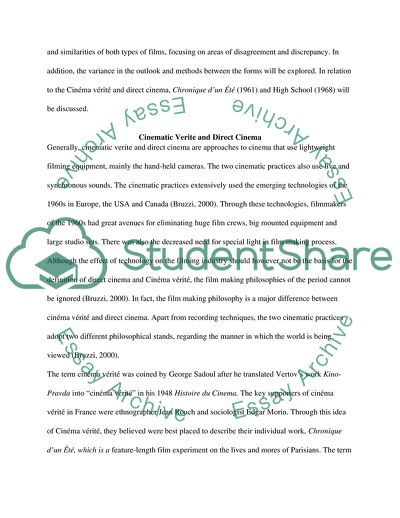Cite this document
(Direct Cinema and Cinma Vrit Coursework Example | Topics and Well Written Essays - 2250 words, n.d.)
Direct Cinema and Cinma Vrit Coursework Example | Topics and Well Written Essays - 2250 words. https://studentshare.org/visual-arts-film-studies/1846534-discuss-the-differences-and-similarities-between-direct-cinema-and-cinma-vrit-using-chronique-dun-t-edgar-morin-1960-and-high-school-frederick-wiseman-1968-as-case-studies-you-should-refer-to-the-opposition-between-the-observational
Direct Cinema and Cinma Vrit Coursework Example | Topics and Well Written Essays - 2250 words. https://studentshare.org/visual-arts-film-studies/1846534-discuss-the-differences-and-similarities-between-direct-cinema-and-cinma-vrit-using-chronique-dun-t-edgar-morin-1960-and-high-school-frederick-wiseman-1968-as-case-studies-you-should-refer-to-the-opposition-between-the-observational
(Direct Cinema and Cinma Vrit Coursework Example | Topics and Well Written Essays - 2250 Words)
Direct Cinema and Cinma Vrit Coursework Example | Topics and Well Written Essays - 2250 Words. https://studentshare.org/visual-arts-film-studies/1846534-discuss-the-differences-and-similarities-between-direct-cinema-and-cinma-vrit-using-chronique-dun-t-edgar-morin-1960-and-high-school-frederick-wiseman-1968-as-case-studies-you-should-refer-to-the-opposition-between-the-observational.
Direct Cinema and Cinma Vrit Coursework Example | Topics and Well Written Essays - 2250 Words. https://studentshare.org/visual-arts-film-studies/1846534-discuss-the-differences-and-similarities-between-direct-cinema-and-cinma-vrit-using-chronique-dun-t-edgar-morin-1960-and-high-school-frederick-wiseman-1968-as-case-studies-you-should-refer-to-the-opposition-between-the-observational.
“Direct Cinema and Cinma Vrit Coursework Example | Topics and Well Written Essays - 2250 Words”. https://studentshare.org/visual-arts-film-studies/1846534-discuss-the-differences-and-similarities-between-direct-cinema-and-cinma-vrit-using-chronique-dun-t-edgar-morin-1960-and-high-school-frederick-wiseman-1968-as-case-studies-you-should-refer-to-the-opposition-between-the-observational.


